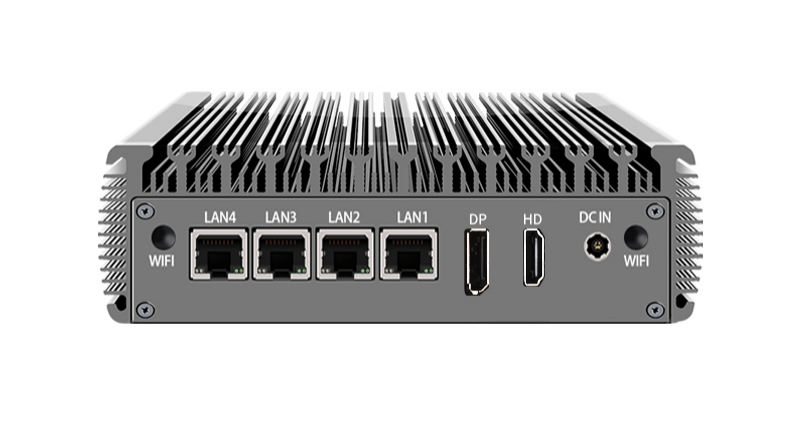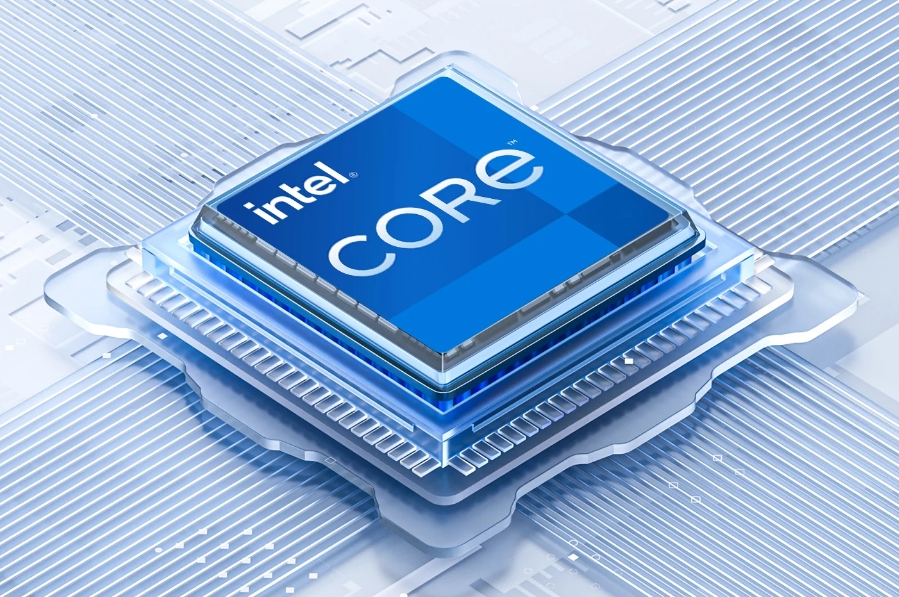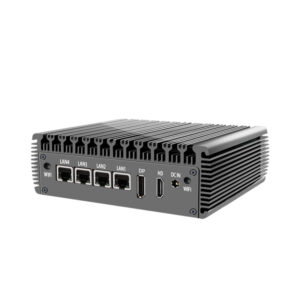We observed that increasing the ambient temperature from 25°C to 45°C caused an average CPU clock speed drop of 15% under sustained load. At the same time, thermal throttling was triggered to prevent overheating when the temperature exceeded 55°C. These data highlight the importance of environmental conditions on the performance of passively cooled mini PCs. Ambient temperature affects different aspects of using the Intel N100 fanless mini PC, including thermal design constraints, performance scaling, system stability, reliability, and lifespan.
Thermal Design and Passive Cooling Limitations of Intel N100 Fanless Mini PC
The Intel N100 Fanless Mini PC relies entirely on passive cooling, which conducts away the heat generated by the quad-core processor through a rugged aluminum chassis and an array of heat pipes. Unlike active mini PCs with fans, this design eliminates moving parts but limits heat dissipation to natural convection and conduction. For example, when the ambient temperature is below 30°C, the integrated heat sink keeps the CPU junction temperature below 85°C during full-load benchmarks.
Additionally, as ambient temperature approaches 50°C, thermal gradients shrink, reducing heat transfer efficiency and causing CPU frequency to drop to 1.5 GHz instead of the nominal 2.4 GHz peak. We employ thermally conductive materials and chassis vents based on worst-case environmental conditions to ensure that the Intel N100 Fanless Mini PC can operate reliably without fans. We also performed CFD simulations to verify that maintaining a 10 mm gap around the chassis maximizes convective airflow and optimizes heat dissipation.

Performance Scaling Across Temperature Range
Second, ambient temperature directly affects the sustained performance of the Intel N100 Fanless Mini PCs. In the benchmark run, the average score at 25°C was 1,500 points, while at 45°C the score dropped to 1,275 points, a 15% drop in performance. In addition, single-threaded performance dropped by 10%, affecting latency-sensitive applications such as web browsing or virtualization. We calibrate the system’s BIOS-level power limits to minimize throttling, but environmental conditions ultimately limit how long the N100 can maintain peak clocks. These scaling curves allow customers to predict performance at their specific deployment temperatures. Additionally, data from extended testing shows that performance recovery takes approximately 20 minutes after returning to a cooler environment, demonstrating the importance of system cool-down periods in operational planning.
System Stability for Intel N100 Fanless Mini PC
Maintaining system stability at high ambient temperatures is critical to any deployment of the Intel N100 Fanless Mini PC. When the ambient temperature exceeds 55°C, the embedded controller initiates dynamic voltage and frequency scaling to prevent the CPU junction temperature from exceeding 100°C. I implemented hysteresis in the throttling thresholds to avoid oscillations between performance states. Additionally, the N100’s integrated temperature sensor provides real-time feedback to the firmware, enabling smooth transitions rather than abrupt shutdowns. This controlled throttling mechanism ensures continued operation without system crashes even in demanding thermal environments. Our stress test of 72 hours of continuous workload confirmed that the system did not experience any spontaneous reboots or blue screens when the ambient temperature was below 60°C, highlighting its strong stability.

Reliability, MTBF, and Component Lifetime
In addition to the direct impact on performance, high ambient temperature also accelerates the wear of electronic components, thereby reducing the mean time between failures of the Intel N100 fanless mini PC. In addition, the service life of electrolytic capacitors is approximately halved for every 10°C increase in operating temperature. Therefore, running the mini PC at 60°C instead of 25°C may reduce component life by up to 50%. I chose industrial-grade capacitors rated for 105°C and high TBW, solid-state storage to enhance durability. This component selection strategy, combined with passive cooling, improves reliability even at elevated ambient temperatures. Data logging of field devices shows that devices operating at 40-50°C can still achieve MTBFs of more than 50,000 hours, validating our component selection.
High Temperature Mitigation Strategies
To mitigate the effects of ambient heat on the Intel N100 Fanless Mini PC, in addition to the chassis-mounted heat sink, I integrated optional thermal pads to connect the internal hotspot to the case. As a result, the surface temperature remains below 60°C even at 45°C ambient. I also recommend regular firmware updates to fine-tune the DVFS table to the new environmental profile. At the same time, adding an external passive heat sink or mounting on a metal backplate can increase the effective thermal mass. These measures can both maintain performance and extend component life, allowing the mini PC to operate in warmer environments without active cooling. Field trials have shown that adding just two 5mm copper plates can reduce the internal peak chip temperature by 8°C.
Reducing the Impact of Ambient Temperature
Ambient temperature has a profound impact on the Intel N100 Fanless Mini PC, affecting sustained performance, system stability, component reliability, and more. I will use rigorous thermal design, industrial-grade components, strategic deployment planning, and continuous monitoring to mitigate the high temperature challenges. By following these professional best practices, enterprises can maximize the performance, reliability, and life of the Intel N100 Fanless Mini PC, even in harsh environmental conditions.




